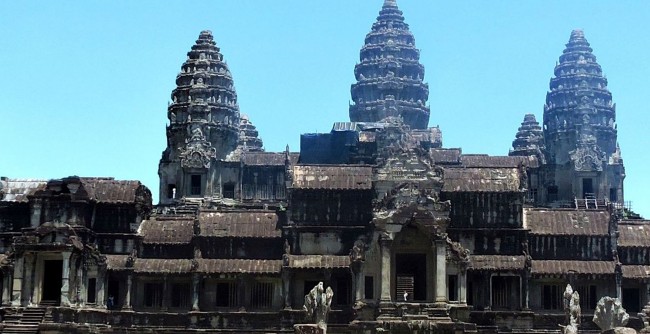Angkor Wat is, without question, one of the premiere man-made wonders of the world. It is the largest religious monument in the world and has lost little of its grandeur since the time it was built. It is also the most recent of some 70 temples the Khmers built over hundreds of years, dating back to the 800s. The Khmers built this temple in the early 12th century – some 900 years ago. Angkor Wat (which means Capital Temple in Khmer) is located near Siem Riep in northwestern Cambodia.
Like all religious buildings, it was designed to be awe-inspiring, and it achieves its purpose remarkably well. The site itself is separated from the rest of the area with a moat 70 meters wide. The moat is symbolic of the Cosmic Sea, the source of creative energy and life for Hindus and the starting point for the journey to salvation. Once visitors cross the moat, they find four massive enclosure walls. These walls represent sacred mountain ranges and the obstacles devotees must overcome on the path to enlightenment.  They are laid out in a concentric arrangement and the space enclosed within each successive set of walls becomes significantly more sacred. The extensive enclosure walls are lined with continuous covered galleries. The images on these walls may depict either the major stories of the Hindu religion or the major events in the history of the Khmer culture. They have no inscriptions to explain their meanings. Rather, visitors are expected to make an immediate connection between the images and the stories behind those images, much like the Christian nativity scene and its interpretation. The images at Angkor Wat, however, were based on a new model. Previous images represented only one part of a story – these show an advancing, continuous narrative.
They are laid out in a concentric arrangement and the space enclosed within each successive set of walls becomes significantly more sacred. The extensive enclosure walls are lined with continuous covered galleries. The images on these walls may depict either the major stories of the Hindu religion or the major events in the history of the Khmer culture. They have no inscriptions to explain their meanings. Rather, visitors are expected to make an immediate connection between the images and the stories behind those images, much like the Christian nativity scene and its interpretation. The images at Angkor Wat, however, were based on a new model. Previous images represented only one part of a story – these show an advancing, continuous narrative.
The outer wall is 1024 meters long, 802 meters wide and 4.5 meters high. This outer wall encloses a space of 820,000 square meters (203 acres). It not only enclosed the temple proper but a city of some 10,000 people as well. The royal palace was located to the north of the temple. These massive buildings and walls of brick, sandstone and laterite contain no mortar whatsoever. Rather, the stones were precisely hewn and fitted together tightly.
The complex is stunning due to its pure magnitude, its architecture and its carved relief murals. They operate in harmony to create a presence that lends reality to the direct connection between the mortal and divine worlds. According to Maurice Glaize, a mid-20th-century conservator of Angkor, the temple “attains a classic perfection by the restrained monumentality of its finely balanced elements and the precise arrangement of its proportions. It is a work of power, unity and style.”
At the very centre of Angkor Wat, but visible from a great distance, is a collection of five sanctuary towers. These towers not only represent the mountaintop residence of the Hindu Gods, they may well have been the actual residence of the Gods themselves. God’s Cave is directly under the central tower. This is the place where God descends from his mountain home and becomes accessible to mortals.
There is a divine intersection between the vertical access from the mountaintop to the cave and the visitors’ horizontal axis from the temple entrance to the cave. This intersection is the centre of the universe. This is where man joins with God; unity between man and God is the purpose of earthly existence. The Hindu God temporarily physically inhabits his representation in the sanctuary in the cave. The temple is designed to enable the direct devotee-to-deity interaction. This is quite different from all other faiths, including Christianity, because there is no religious intermediary between God and man. At this place, God is manifest before the devotee and it is a profound encounter.
Angkor is one of the most important archaeological sites in South-East Asia and extends over some 400 sq km, including forested area. The Angkor Archaeological Park contains the magnificent remains of the different capitals of the Khmer Empire from the 9th to the 15th century. They include the famous Temple of Angkor Wat and, at Angkor Thom, the Bayon Temple with its countless sculptural decorations. Towards the end of the 12th century, Angkor Wat was gradually transformed from a Hindu centre of worship to a Buddhist site and maintains that orientation today.
Angkor Wat and the Khmer temples, dating back to the 7th century, rank among the most impressive sites in the world. Cambodia takes great pride in these sites and collaborates with a variety of countries to restore the temples to their previous glory. It features prominently on the Cambodian flag as well as in its relations with France, the United States and neighboring Thailand. Angkor is also a UNESCO World Heritage Site, and UNESCO has set up a wide-ranging program to safeguard this symbolic site and its surroundings.
Visitors to Indochina who miss a visit to Angkor Wat also miss a life-changing opportunity.
Photo Credits
Photos by Jan Wall – all rights reserved







Hey Jan…how can I get in touch with you?
Beautiful explained how thesentemplewas built in early years. Been in the place and was amazed of its contructions.
thanks for the info.
Truly an amazing place !!!!!!